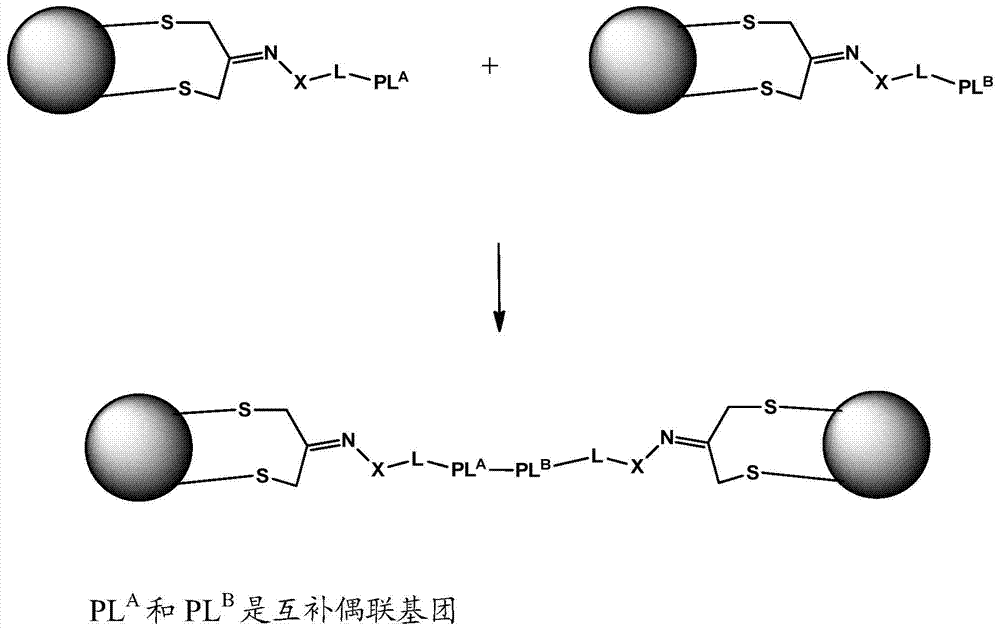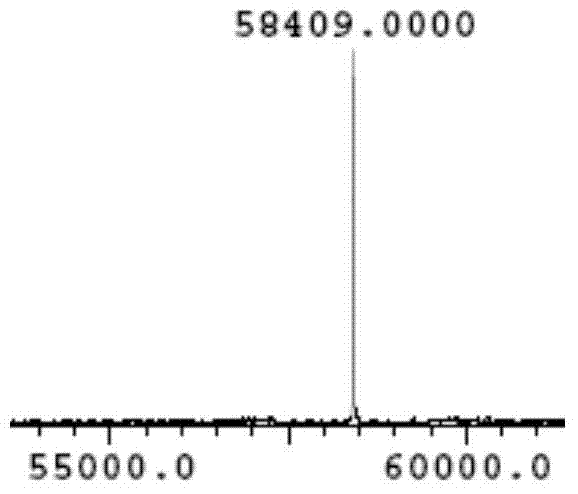Methods for making conjugates from disulfide-containing proteins
A protein and conjugate technology, applied in the field of immobilizing proteins, can solve problems such as stability issues
- Summary
- Abstract
- Description
- Claims
- Application Information
AI Technical Summary
Problems solved by technology
Method used
Image
Examples
Embodiment 1
[0144] Treatment of CRM197 with TCEP(xx) (see: G. Giannini and R. Rappuoli, Nucleic Acids Res., 1984, 25, 4063.), resulted in the reduction of C201-C185 disulfides, but little or no reduction of C451- C471 disulfide (see Example 3). The reduced CRM197 was treated with 1,3-dichloroacetone to obtain activated protein with intact C451-C471 disulfide, and C201 passed -CH 2 -C(=O)-CH 2 -The linker is connected with C185. The activated protein is contacted with PL1 (the PL1 is an aminooxy group-containing aminated fatty acid derivative whose preparation method is as described above), thereby forming an oxime that links the fatty acid derivative with the protein. Conjugates with linked fatty acid groups are expected to reduce renal clearance, thereby prolonging the circulating half-life of the CRM197 protein and improving its usefulness as a carrier for conjugate vaccines. Figure 3 provides natural protein ( Figure 3A , Use method A), activated protein ( Figure 3B ) And protein con...
Embodiment 2
[0159] Raw material preparation: pE-R-P-R-L-C-H-K-G-P-Nle-C-F-OH (disulfide C 6 -C 12 )(8) Synthesis
[0160]
[0161] ●Preparation of Intermediate 8a
[0162] (Use Fmoc-F-OH to load 2-chlorotrityl chloride resin, remove Fmoc and determine the resin loading)
[0163] Wash the 2-chlorotrityl chloride resin (40.0 g, 64.0 mmol) with DCM (3x). A solution of Fmoc-F-OH (24.8 g, 64.0 mmol) in DCM (400 mL) and DIPEA (44.7 mL, 256 mmol) was added, and the suspension was shaken at room temperature for 22 h. The resin was washed thoroughly with DCM / MeOH / DIPEA (17:2:1) (3x), DCM (3x), DMA (3x), DCM (3x). The resin was then treated with a piperidine / DMA (1:4) mixture (400 mL) 4 times for 10 minutes, and then washed with DMA (2x 180 ml). Collect piperidine / DMA solution and DMA washing solution for determination of resin loading. 1 mL of the combined solution was diluted to 500 mL with MeOH, and the UV absorption at 299.8 nm was determined to be A=0.368. This corresponds to an Fmoc amount of 4...
Embodiment 3
[0180]
[0181] To CRM197 (200μg, 6.2ul, 0.0034μmol) in 50mM sodium phosphate buffer pH7.4 (10μl) was added TCEP HCl (5.89μg, 0.021μmol) aqueous solution. The reaction mixture was left at room temperature for 15 h. 1,3-Dichloropropan-2-one (4.58μg, 0.034μmol 10eq) was added to the mixture. The reaction was left at room temperature for 2h. Pass the crude product through Zeba TM Size exclusion column. LCMS; [M+1]=58465. This activated protein can react with an aminated payload such as a TLR agonist to form a carrier protein conjugated with a compound that can increase the immune response to any antigen added to the carrier protein.
[0182]
[0183] To the ketone-modified CRM197 solution (5mg / ml, sodium phosphate buffer, pH 6.0) (50μg, 0.00086μmol) was added N-(3-(4-(2-(4-(2-(5-amino- 8-methylbenzo[f][1,7]naphthyridin-2-yl)ethyl)-3-methylphenoxy)ethyl)piperazin-1-yl)propyl)-2-( Aminooxy)acetamide (66.8μg, 0.064μmol) and aniline (0.0020μl, 0.021μmol). The reaction was placed a...
PUM
| Property | Measurement | Unit |
|---|---|---|
| molecular weight | aaaaa | aaaaa |
Abstract
Description
Claims
Application Information
 Login to View More
Login to View More - R&D
- Intellectual Property
- Life Sciences
- Materials
- Tech Scout
- Unparalleled Data Quality
- Higher Quality Content
- 60% Fewer Hallucinations
Browse by: Latest US Patents, China's latest patents, Technical Efficacy Thesaurus, Application Domain, Technology Topic, Popular Technical Reports.
© 2025 PatSnap. All rights reserved.Legal|Privacy policy|Modern Slavery Act Transparency Statement|Sitemap|About US| Contact US: help@patsnap.com



